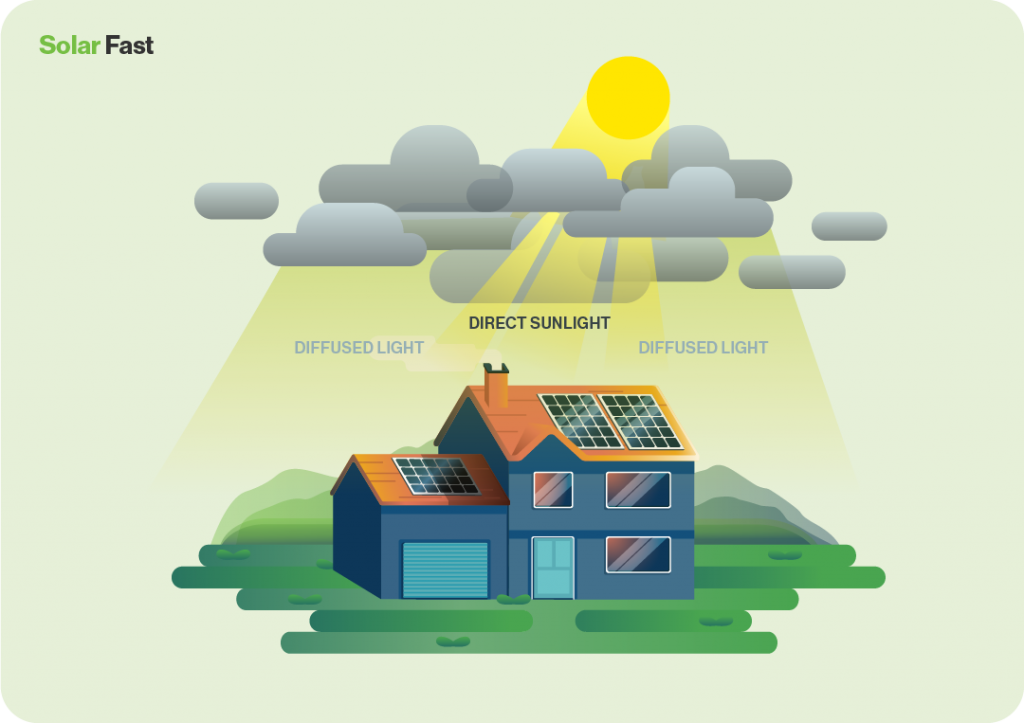There is a popular misconception that solar panels, and therefore solar energy systems, only work when the sun is shining and there are no clouds in the sky.
But, solar panels are light activated, not sunlight activated, so it’s daylight that gets the silicon jumping to make the electricity for your home.
Let’s just get into that before we talk about wintry weather and snow.
How do solar panels make electricity?
The magic ingredient in a solar panel is silicon, the world’s second most abundant element and the key for turning light energy into electric energy.
Light is made up of tiny particles called photons and, when these hit purified silicon, they ‘jiggle’ the molecules in the silicon to create electricity.
That electricity then makes its way to the conductors attached to the cell and off into your home.
Do low temperatures affect solar panels?
As we mentioned earlier, PV solar panels work on daylight, so it’s not the sun’s heat that creates the electricity but the photons in that light.
Theoretically, if you had the same light on a cold day as you do on a warm day, you’d actually get more electricity generation because lower temperatures = higher voltage.
Of course, that’s not how the world works, so you will likely generate less electricity when it’s cold asd the days are shorter.
Plus, in winter, the sun’s rays are hitting the earth at a much shallower angle, particularly here in Northern Europe.
The advantage of chilly weather is that the silicon is kept cool and cold silicon is less resistive – meaning the electrons can flow much more freely.
Will solar panels work when it’s snowing?
Just like rain and hail, solar panels will work fine when it’s sleeting or snowing.
The light is still getting to the panels through the cloud and the energy is still being fed into your home.
Amazingly, research has found that there needs to be almost 5cm of snow on your panel before it stops working completely!
The panels themselves have a built in defence mechanism anyway.
Panels are slightly warmer than the air because they are reacting to the light to generate energy, this creates a small amount of heat, not too much but just enough to raise the temperature of the casing. This melts the snow as it settles.
The angle of the panels also helps to slide the snow off the surface, especially if the snow touching the glass is melting due to the small temperature difference.

So, how much power am I getting in winter?
We estimate that your solar energy system will produce about 10% – 20% of its full protentional in the winter in the UK.
Depending on the size of your system, the way you use this electricity and how much storage you have, this may be enough to power your home and, even if not, you are still saving money.
An average installation, 12 panels and 2 batteries, will produce around 30kWh a day on a good day in the summer – so we are still getting a good 3 – 6 kWh a day even with a weak sun and unsettled weather.
If you are out during the day, you can store all that lovely energy in your batteries.
What is the optimal temperature for solar panels?
Superior quality, Tier 1 solar panels are tested with some pretty rigorous scenarios before they leave the factory.
As well as hail, rain and hurricane tests they’re also subjected to widely varying temperatures to make sure they can function in all weathers.
Panels can be tested at temperatures from minus 40°C to plus 85°C, though these are very extreme.
The optimum temperature for a panel is around 20°C because the cooler the panel, the more efficient it is.


